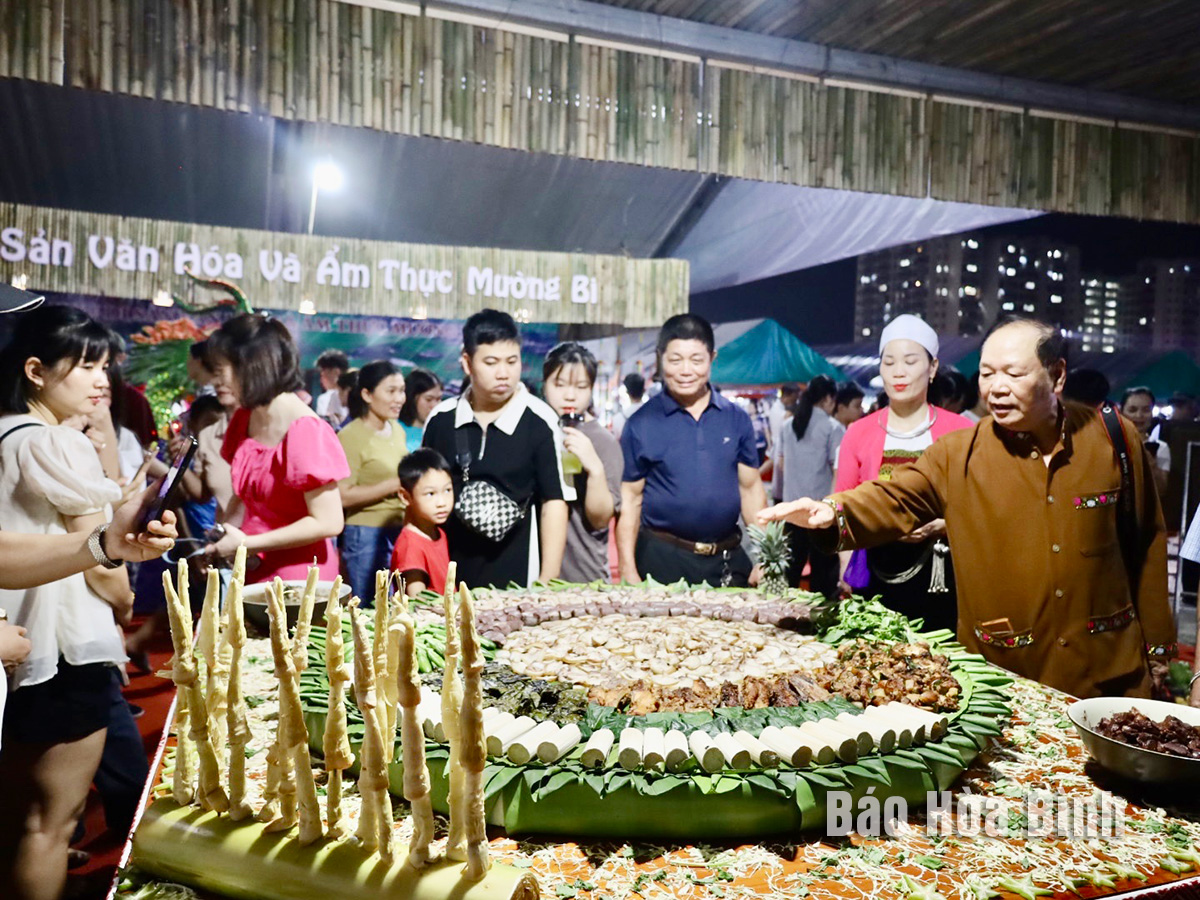
Alongside the diverse cultural identities of the Kinh, Muong, Tay, Thai, Dao, and Mong ethnic people, Hoa Binh province is also renowned as the "capital" of the northwestern Vietnamese cuisine, offering unique and distinctive dishes. At festivals, during Lunar New Year (Tet), or on significant family or community occasions, special dishes are prepared, leaving a lasting impression on visitors.

A
leave-based feast of the Muong people is often introduced to visitors at
cultural and tourism events of Hoa Binh province.
The Muong people, who make up over 63% of the
population in Hoa Binh, have a rich culinary tradition. Dishes such as grilled
fish, fermented pork, bitter bamboo shoots, coloured sticky rice, com lam
(bamboo rice), and rice wine are part of their culinary heritage. Among these,
the sour bamboo chicken soup has become a signature dish of Hoa Binh cuisine.
The chicken, raised free-range and weighing about 1 kg, is cleaned and cut into
small pieces, marinated with fermented bamboo and spices for 20-30 minutes
before being simmered on a charcoal stove for 1-2 hours. Once the chicken and
bamboo are tender, they are sprinkled with crushed roasted "doi"
seeds.
"Ruou can" (rice wine) is an indispensable
drink in Muong households for welcoming guests, celebrating weddings,
housewarming events, and religious ceremonies. The communal drinking tradition
reflects the spirit of togetherness as people sit in a circle to enjoy the
smooth, sweet, and intoxicating taste of rice wine, accompanied by the sound of
gongs filling the festive air.
The Muong people also bring a simple yet
delightful dish called "steamed vegetables", which adds visual appeal
and also flavour to meals.
The Thai people of Mai Chau have contributed to
the unique cultural identity of Hoa Binh, with their rich culinary traditions
being an important part of the district's heritage. In Mai Chau's
community-based cultural tourism villages, visitors flock to experience local
specialties. The Thai people's farming practices and lifestyle have created a
wealth of traditional dishes such as bamboo rice, dried buffalo meat, and
bitter bamboo shoots. Many of these time-honoured dishes continue to evolve as
locals learn to improve their quality to meet the tastes of modern travellers.
Mai Chau sticky rice is cooked in wooden
steamers by Thai women. The sticky rice is typically served with hill chicken,
grilled stream fish, or pork. Another dish, "com lam" (bamboo rice),
is prepared by placing sticky rice into bamboo tubes, sealing them with dry
banana leaves, and roasting them over an open fire. The result is a unique
flavour where the rice's chewiness blends with the fragrant aroma of bamboo and
banana leaves.
Each ethnic group in Hoa Binh brings its own
culinary specialty, creating a diverse and rich food culture. This diversity
forms a vital foundation for the province's growing tourism industry, giving
visitors to Hoa Binh lasting memories and a deep appreciation for the
time-honoured dishes of the local ethnic communities.
A diverse chain of eco-tourism and resort destinations concentrated in Hoa Binh city and the districts of Tan Lac, Da Bac, and Luong Son… Along with the launch of several key high-quality resort tourism projects, these developments have reshaped the landscape and enhanced the appeal of Hoa Binh as a travel destination.
Boasting diverse terrain, a mild climate, and rich natural resources, Cao Phong district is increasingly asserting its place on Vietnam’s tourism map, attracting both domestic and foreign visitors. The district is renowned for its stunning landscapes, majestic mountains, a crystal-clear hydropower lake, and the unique cultural identity of local ethnic groups.
With its pristine landscapes, unique cultural heritage of Muong ethnic minority, and an expanding range of visitor experiences, Tan Lac district of Hoa Binh has fast become a captivating destination for both domestic and international tourists.
Until now, Sung village in Cao Son commune, Da Bac district remains the only Dao ethnic community in Hoa Binh province to develop a community-based tourism model. Beyond its untouched natural landscapes, cultural identity serves as the cornerstone attraction for visitors.
A Phong Linh (Yellow Tabebuia) flower garden in Thang village, Thach Yen commune, Cao Phong district is currently in full bloom, drawing a large number of visitors.
Community-based tourism has been thriving in Pa Co commune, Mai Chau district thanks to advantages in natural landscape and cultural identity.



